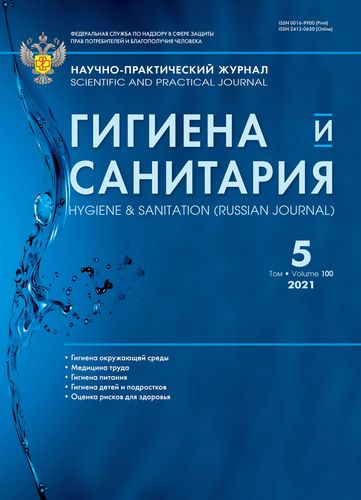Occupational health risk management system for greenhouse vegetable growers
- Authors: Novikova T.A.1, Bezrukova G.A.1, Migacheva A.G.1, Spirin V.F.1
-
Affiliations:
- Saratov Hygiene Medical Research Center of the Federal Research Center “Medical and Preventive Health Risk Management Technologies”
- Issue: Vol 100, No 5 (2021)
- Pages: 457-463
- Section: OCCUPATIONAL HEALTH
- Published: 07.06.2021
- URL: https://kld-journal.fedlab.ru/0016-9900/article/view/639264
- DOI: https://doi.org/10.47470/0016-9900-2021-100-5-457-463
- ID: 639264
Cite item
Full Text
Abstract
Introduction. Prevention of chronic general somatic diseases associated with exposure to harmful working conditions is one of the primary measures to preserve the health of the working population and labor resources of the Russian Federation. However, insufficient attention is paid to the management of occupational health risks of agricultural workers, including greenhouse vegetable growers.
Materials and methods. Hygienic and epidemiological studies were carried out based on the methodology for assessing and managing occupational health risks.
Results. A complex of harmful occupational factors, including high temperatures and humidity, harmful chemicals, including pesticides, plant dust, and the labor process’s severity simultaneously affect working greenhouse growers. Working conditions were assessed as harmful (classes 3.2-3.3) of occupational risk categories from medium to high. Direct statistically significant correlations were established between the length of occupational service and diseases of the respiratory system, circulatory system, musculoskeletal system, and connective tissue (respectively r = 0.58; r = 0.6; r = 0.35). A high degree of causal relationship with the work in harmful occupational conditions of arterial hypertension (RR = 2.805; EF = 64.35%; CI = 1.498-5.253), radiculopathy of the lumbosacral spine (RR = 2.290; EF = 56%; CI = 1.140- 4.599), an average degree of uterine fibroids (RR = 1.969; EF = 49%; CI = 0.988-3.926) and chronic bronchitis (RR = 1.532; EF = 34.7%; CI = 0.682-3.442), which allows classifying them as occupationally conditioned. The system of preventive measures to minimize occupational risks and prevent occupational diseases has been scientifically substantiated.
Conclusion. Current working conditions of greenhouse vegetable growers are characterized by the impact of harmful occupational factors promoting occupationally caused diseases, which requires the implementation of a set of preventive measures based on a risk-oriented approach.
About the authors
Tamara A. Novikova
Saratov Hygiene Medical Research Center of the Federal Research Center “Medical and Preventive Health Risk Management Technologies”
Author for correspondence.
Email: novikovata-saratov@yandex.ru
ORCID iD: 0000-0003-0366-856X
MD, Ph.D., head of the Laboratory of Occupational Health, Saratov Hygiene Medical Research Center of the FBSI «FSC Medical
and Preventive Health Risk Management Technologies», 410022, Saratov.
e-mail: novikovata-saratov@yandex.ru
Russian FederationGalina A. Bezrukova
Saratov Hygiene Medical Research Center of the Federal Research Center “Medical and Preventive Health Risk Management Technologies”
Email: noemail@neicon.ru
ORCID iD: 0000-0001-9296-0233
Russian Federation
Anna G. Migacheva
Saratov Hygiene Medical Research Center of the Federal Research Center “Medical and Preventive Health Risk Management Technologies”
Email: noemail@neicon.ru
ORCID iD: 0000-0002-1162-3364
Russian Federation
Vladimir F. Spirin
Saratov Hygiene Medical Research Center of the Federal Research Center “Medical and Preventive Health Risk Management Technologies”
Email: noemail@neicon.ru
ORCID iD: 0000-0002-2987-0099
Russian Federation
References
- Zaytseva N.V., Popova A.Yu., Onishchenko G.G., May I.V. Current problems of regulatory and scientific-medical support for the assurance of the sanitary and epidemiological welfare of population in the Russian Federation as the strategic government task. Gigiena i Sanitaria (Hygiene and Sanitation, Russian journal). 2016; 95(1): 5–9. https://orcid.org/10.18821/0016-9900-2016-95-1-5-9 (in Russian)
- Strengthening the Role of Employment Injury Schemes to Help Prevent Occupational Accidents and Diseases. Programme on Safety and Health at Work and the Environment. Geneva: International Labour Office; 2012.
- Yatsyna D.S., Borisova L.S. Evaluation of health workers greenhouse farms. Prikladnye informatsionnye aspekty meditsiny. 2016; 19(4): 103–13. (in Russian)
- Yatsenko L.A., Borisov N.A., Klepikov O.V. Hygienic assessment of occupational risk factors for the health of greenhouse workers. Sanitarnyy vrach. 2018; (10): 45–54. (in Russian)
- Migacheva A.G, Novikova T.A., Spirin V.F., Shlyapnikov D.M. A priori assessment of occupational health risk for greenhouse workers. Analiz riska zdorov’yu naseleniya. 2017; (3): 101–9. (in Russian)
- Skulskaya L., Shirokova T. Рroblems and prospects of vegetable growing of the closed soil. Norwegian Journal of Development of the International Science. 2020; (39): 35–9.
- Klepikov O.V., Mamchik N.P., Gabbasova N.V., Kalashnikov Yu.S. Influence of work conditions on health state of workers engaged into hothouse production. Meditsina truda i promyshlennaya ekologiya. 2016; (7): 21–5. (in Russian)
- Bakusic J., Lenderink A., Lambreghts S. Different approaches for early recognition and prevention of new and emerging work-related diseases. Occup. Environ. Med. 2017; 74 (Suppl. 1): A53.2–A53.
- Bereznyak I.V., Rakitskiy V.N., Mikheeva E.N., Yarygin I.V. The risk to health of operators under application of pesticides in agriculture. Zdravookhranenie Rossiyskoy Federatsii. 2017; 61(4): 185–90. https://orcid.org/10.18821/0044-197Kh-2017-61-4-185-190 (in Russian)
- Babanov S.A., Baraeva R.A. Occupational lesions of the cardiovascular system. Russkiy meditsinskiy zhurnal. 2015; 23(15): 900–6. (in Russian)
- Izmerov N.F., ed. Occupational Pathology. National Guidelines [Professional’naya patologiya: natsional’noe rukovodstvo]. Moscow: GEOTAR-Media; 2001. (in Russian)
- Samykina E.V., Samykin S.V. The impact of heating microclimate as a priority risk factor for occupational diseases. Vestnik meditsinskogo instituta «REAVIZ»: Reabilitatsiya, vrach i zdorov’e. 2017; (5): 144–7. (in Russian)
- Dautov F.F., Zamalieva M.A., Yusupova N.Z. Unspecific immunological resistance of children whose mothers work in hothouses. Kazanskiy meditsinskiy zhurnal. 2008; 89(1): 75–8. (in Russian)
- Fesenko M.A., Sivochalova O.V., Fedorova E.V. Occupational reproductive system diseases in female workers employed at workplaces with harmful working conditions. Analiz riska zdorov’yu. 2017; (3): 92–100. https://orcid.org/10.21668/health.risk/2017.3.11 (in Russian)
- Potapov A.I., Rakitskiy V.N., Bereznyak I.V. Complex Exposure to Chemicals in Industrial and Agricultural Conditions [Kompleksnoe vozdeystvie khimicheskikh veshchestv v usloviyakh promyshlennogo i sel’skokhozyaystvennogo proizvodstva]. Мoscow: Shiko; 2012. (in Russian)
- Chen G.X., Mannetje A.M., Douwes J., Van den Berg L., Pearce N., Kromhout H., et al. Occupation and motor neuron disease: a New Zealand case-control study. Occup. Environ. Med. 2019; 76(5): 309–16. https://doi.org/10.1136/oemed-2018-105605
- Goncharenko I.M., Komleva N.E., Chekhonatsky A.A Lower back pain at workplace: prevalence and risk factors. Russian Open Medical Journal. 2020; 9(2): 207. https://doi.org/10.15275/rusomj.2020.0207
Supplementary files









